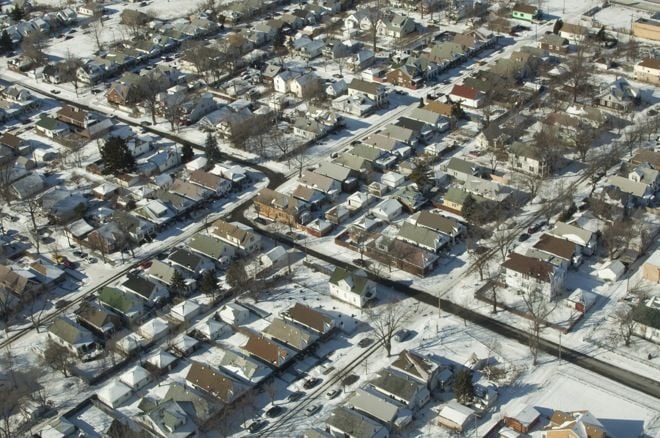In “Michigan: Detroit in Decline” – an article written by TIME magazine in 1961, which sadly remains relevant today, the words of Henry Ford II resonate strongly in relationship to a Detroit-based non-profit: “Detroit admittedly has its problems – intelligent citizen interest and action can solve them. As I see it, the vital need now is for the people themselves to become interested in the community and government, and to take an active part in their affairs.”
Exemplifying ‘intelligent citizen interest and action’, Power House Productions (PHP) is working to help stabilize and revitalize their city – specifically in a Detroit neighborhood near Hamtramck – through the arts and other cultural endeavors.
Formed in 2009, PHP is run by architect and artist couple, Gina Reichert and Mitch Cope, and is a result of their own Power House project, which began back in 2008. Their work soon grew beyond one house to a point where, as is written on the PHP website, “it was necessary to establish a more structured organization”.
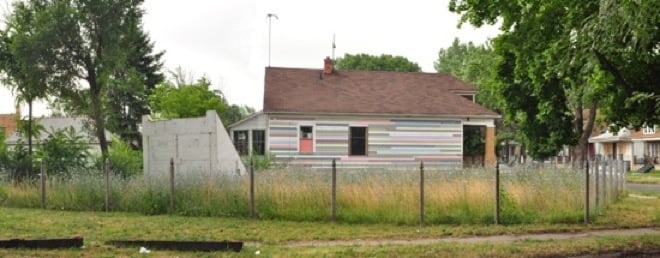
The Power House, a formerly foreclosed drug house purchased for $1900 in 2008 was how it all begin for Detroit-based Power House Productions | © Mitch Cope
Located just around the corner from their residence, the Power House was a formerly foreclosed drug house that Reichert and Cope purchased for $1900. The home was one amongst several of a new crop of vacancies, as Reichert put it, that the couple took note of one year after the purchase of their residence in 2005. This, along with an arson, changed the feel of the neighborhood for them and pushed them to take action. “We started to be more active out of necessity,” said Reichert.
With minimal financial risk, the couple envisioned being able to implement their long-held interest in setting up an artist residency (throughout the years they had been hosting various artists in their own home and felt it was time to maintain a bit more privacy for themselves) and also their idea to “play with the space”, Reichert said.
The art and design duo coined the name Power House to describe the home’s ability to literally power itself through the generation of its own electricity and heat (via a solar power setup that includes a roof redesign implemented this past winter) as well as the home’s significance as “a kind of taking control of ones own community by becoming an example of self reliance, sustainability, and creative problem solving through education, communication and increased diversification of the neighborhood, ” as written on the PHP website.
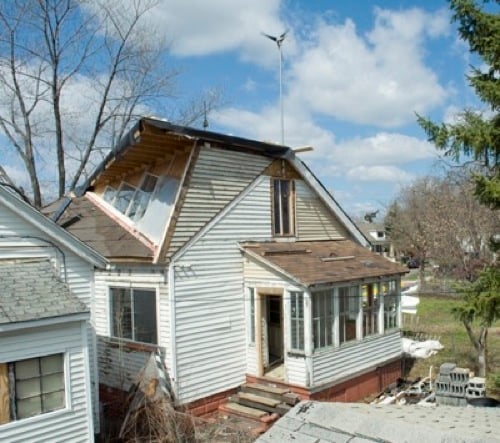
The Power House is named for its ability to power itself through the generation of its own electricity and heat | © Mitch Cope
The Power House started “a chain of events”, as Reichert described, leading to the purchase of several other formerly foreclosed homes by artist friends of the couple – including the now infamous $100 home, purchased in 2009 by couple Jon Brumit and Sarah Wagner who had been living in Chicago and expressed concerns about the high cost of living there to Reichert and Cope who sent them the listing for the home. In 2010, a generous grant given to PHP by art magazine, Juxtapoz, resulted in the purchase of four other homes on the nearby Moran Street, which served as three-dimensional canvases for six artists selected by the magazine to put their artistic mark on the vacant homes in October 2010. The grant, and the activities it generated, was the impetus behind the formation of PHP.
Today, the Power House, which remains one among the three homes privately owned by Reichert and Cope, continues to serve its original function as an artist residency, able to accommodate one person or a couple. Its current resident is Dutch architect Guido Marsille, who describes himself and his activities on his twitter account as “designer/public space/interior architecture/ furniture/pre-resident Detroit powerhouse”.
Describing Marsille’s residency work as centered on community dining and eating, Reichert elaborated, “Guido’s work addresses the idea of public and private contradictions, asking the questions, ‘What can a house be, other than a private dwelling? Can it have a function as a catalyst in a street, neighborhood and wider area?” she said. “Specifically he is working in the kitchen space, opening it up to better connect [with the home’s] garden and backyard areas.”
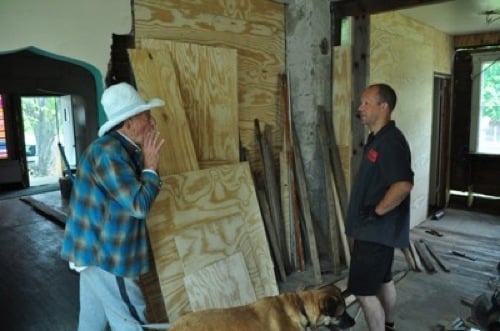
Current Power House artist-in-residence, Guido Marsille, discussing his project with some residents of the neighborhood | © Mitch Cope
In addition to managing the residencies at the Power House, PHP keeps itself busy through its other properties, including the Jar House – destined, once its renovations are complete, to become the new headquarters of the organization (which currently runs out of a room in their private home) and offer a space for mainly writer and curator residencies in its two upper level guest rooms, the Yellow House – a rental home currently being leased to two artists, the R&R House (artists RETNA and Richard Colmans’ Juxtapoz project) and the site of perhaps PHP’s most timing consuming project at the moment, the Skate House and four vacant lots.
“We are currently fundraising for this project,” said Reichert, “We are in the running for a $50,000 Pepsi Refresh grant.”
The project is set to transform the empty lots into a skate park incorporating sculptures, trees and the house, which runs in front of the lots and will serve as a community check point and a place where skaters can rent equipment for example. The project will also incorporate some of the alleys. As written on the PHP website, “The outdated alley infrastructure is often a site for crime, from illegal dumping to violent assaults…. Children play in the alleys because there are few other nearby open spaces for recreation. Our proposal is to redesign the alleys so they harness the positive aspects of these throughways…. creating skateboard and bike paths, creating cross country skiing routes, extending backyard gardens….”
To contribute to the project, one of PHP’s next visitors is photographer Joe Brook – a former resident of Detroit, now residing in California’s Bay Area, who is known for his skate photography and has contacts with skate park designers and facilitators, Grindline.
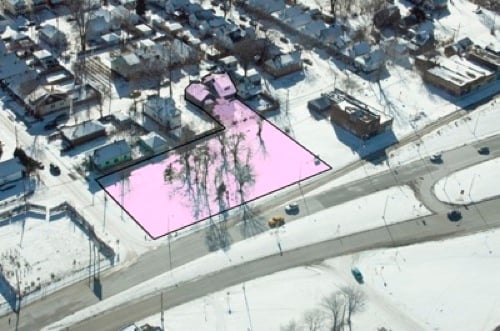
The Skate House project is set to transform 4 empty lots into a skate park incorporating sculpture, trees and the home | © Mitch Cope
In comment to how the efforts of PHP have so far been a benefit to the neighborhood and its inhabitants – a diverse mix, including Polish, Bangladeshi and African Americans, Reichert states that the “art projects are integrated into the daily life of the community” through a variety of interactions including exhibitions held within the houses, open houses, dinners hosted by current Power House resident Marsille and less formal, “everyday” interactions: “When the Juxtapoz houses [were being worked on] the neighbors were curious. They stopped by and looked. This created interaction,” said Reichert.
In addition, Reichert mentions the formation of a block club, which has involved neighborhood cleanups and a chance to discuss new issues where PHP can get other members of the neighborhood to act.
“We are building up a network. It starts with the artists, but quickly involves other members of the community.”
More desirability has been created, which in the last year, has resulted in more residents moving in. In contribution to this effect, PHP worked with the Boarding Coalition, a project of Community Legal Resources and their Detroit Vacant Property initiative, which saw the boarding up of approximately 25 open houses (all under tax foreclosure) in the neighborhood.
“Once that happens people will leave them alone,” said Reichert.
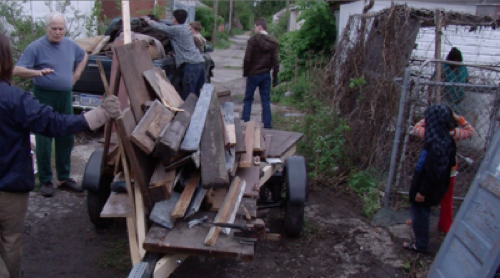
PHP works with their neighbors to haul away debris from a backyard. The camera is mounted on “The neighborhood machine” – a bobcat, aka “hoodcat”, which is part sculpture, part functioning tool | © Mitch Cope
As for the organization’s more long-term goals, they would like to activate the project beyond its current four or five block radius into a larger area, as well as get each of the artist interventions to a certain phase of stabilization, for example, transferring ownership of some of the properties to the artists. This has already happened in the case of one of the homes included in the Juxtapoz project, which was purchased by two of the participating artists the following year.
PHP also has plans to incorporate an educational component in the form of workshops.
“It’s really looking at the changing field of art and design education and how being in the city of Detroit can offer new models for research, investigations and making,” explained Reichert.
In addition, PHP would like to formalize some of their strategies to spread their experiences beyond the borders of Detroit.
“We would like to develop a model that could be applied to other places, “ Reichert said.

